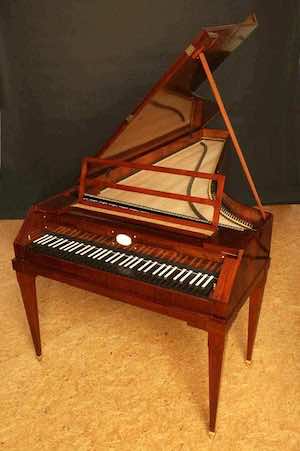Top > Instruments > Comparison of Keyboard Instruments
This site introduces unknown composer Emanuel Bach (C. P. E. Bach). This English version was translated from Japanese one by ChatGPT.
Comparison of Keyboard Instruments
I asked ChatGPT the following question: "While modern pianos are suitable for producing large sounds, aren’t instruments like the fortepiano and clavichord better suited for delicate expression?"
As you mentioned, the fortepiano and clavichord are highly regarded for their ability to produce delicate expressions that differ from those of modern pianos. Each instrument has distinct characteristics that enable nuanced sound and dynamic variations. Below is a detailed explanation of delicate expression through the differences among the fortepiano, clavichord, and modern piano.
Fortepiano
The fortepiano was a keyboard instrument used from the 18th century to the early 19th century, favored by composers like Mozart and Beethoven for both composition and performance. Its key features include a quick attack and a lighter touch compared to modern pianos, making it ideal for delicate expression. The following characteristics highlight its suitability for nuanced performance:
Sound Attack and Decay: The sound of the fortepiano decays faster and is shorter-lived than that of the modern piano. This allows the performer to finely control note duration and decay timing.
Light Touch: The fortepianoʼs lighter keys make it easier for the performer to convey subtle dynamic changes with their fingertips.
Tonal Variety: The structure of the strings and materials of the hammers (leather, felt, etc.) greatly influence the tone, providing performers with a wide range of expressive nuances.
Although the fortepiano is not designed for producing large volumes of sound, it excels in light and intricate tonal expression, making it particularly effective for Classical music.

Clavichord
The clavichord is renowned for its ability to produce extremely delicate expressions. Rather than striking the strings directly, it uses small metal blades called tangents to touch the strings, giving it a unique expressive capability.
Volume Control: Although the clavichord produces very soft sounds compared to other keyboard instruments, it allows for exceptionally precise control over volume and touch.
Vibrato (Bebung): By continuing to press the key, the player can slightly vibrate the string, enabling vibrato—a delicate expression difficult to achieve on other keyboard instruments.
Performance in Quiet Settings: Due to its soft volume, the clavichord is used primarily in quiet environments, allowing the performer to fully express subtle nuances.
The clavichord played an important role in domestic performances during the Baroque and Classical periods, offering delicate dynamics and refined touch.

Modern Piano
The modern piano can produce a wide dynamic range far beyond that of the fortepiano and clavichord. Structurally reinforced, it boasts greater volume and durability, making it suitable for performances with orchestras and in large concert halls. However, it is also capable of delicate expression.
Large Volume: The modern piano can produce very loud sounds, making it ideal for dynamic expressions like forte and crescendo, while also allowing for subtle volume control.
Damper Pedal: The use of the damper pedal enables sustained tones and flexible tonal changes, supporting delicate musical expression.
Tonal Variety: The modern piano has a wider tonal range than the fortepiano or clavichord, adapting to various musical styles.

Summary
Compared to the modern piano, the fortepiano and clavichord are far more suited to delicate and subtle expression. The fortepiano offers quick sound attacks and fine dynamic control, while the clavichord excels in precise volume and touch control. Though the modern piano has a broader dynamic range and is well-suited for grand performances, it lacks the unique sensitivity that the fortepiano and clavichord possess.
Each instrument is best suited to particular musical styles and performance contexts, making the choice of instrument important depending on the intended use.